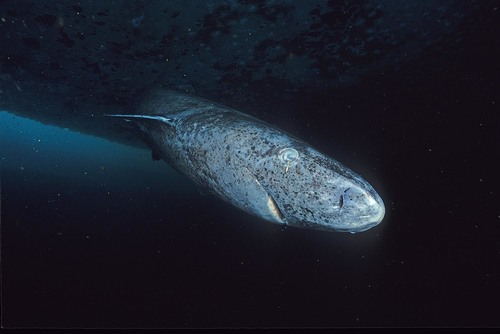
Greenland shark
The Bluefin Tuna (Thunnus) is a group of large, powerful, and highly migratory fish species belonging to the Scombridae family. Renowned for their speed, endurance, and commercial value, Bluefin tuna are apex predators in the marine ecosystem. They are also a critically important species in the food chain and a prized catch in fisheries worldwide.
250 500 years
Lifespan
640 - 730 cm
Length
Near Threatened
Conservation Status
2.6 km/h
Swimming speed
Carnivorous, Scavengers
Diet
Local Migration
Migration
Appearance Overview
The Bluefin Tuna is renowned for its large, streamlined body, built for speed and endurance in the open ocean.
Coloration
Dark metallic blue on top, with a silvery-white underside.
Fins
Two dorsal fins, with the second being taller than the first; small, yellow finlets running down the back and belly.
Body shape
Torpedo-shaped, allowing for efficient movement through water.
Eyes
Relatively small compared to body size, adapted for low-light conditions
Length
Up to 10 feet (3 meters), commonly around 6.5 feet (2 meters).
Weight
Up to 1,500 lbs (680 kg), commonly around 550 lbs (250 kg).
Diet
Carnivorous, feeding on a variety of fish, squid, crustaceans, and occasionally on zooplankton and eels.
Feeding Behavior
Highly active predator, using speed and agility to chase down prey. They often hunt cooperatively, corralling schools of fish.
Social Behavior
Forms large schools, especially when young. Adults can be more solitary but still aggregate during feeding and spawning. Highly migratory, capable of crossing entire oceans
Commercial Relevance
Extremely high value, particularly in the sushi and sashimi markets, where its fatty flesh is considered a delicacy. This high demand has led to significant overfishing
Conservation measures
International fishing quotas, catch limits, and monitoring programs. Efforts to promote sustainable aquaculture and reduce bycatch. Marine protected areas in key spawning and feeding grounds.
Status
Varies by species: Atlantic Bluefin Tuna is Endangered, Pacific Bluefin Tuna is Vulnerable, and Southern Bluefin Tuna is Critically Endangered.
Threats
Overfishing is the primary threat. Climate change impacts ocean temperatures and prey distribution. Bycatch in other fisheries also poses a risk. Habitat degradation affects spawning areas
Habitat Distribution
Depth Range
Typically found from the surface to depths of 1,600 feet (500 meters), but can dive deeper, up to 3,300 feet (1,000 meters) or more.
Geographic Range
Atlantic Bluefin Tuna: Western and eastern Atlantic Ocean, Mediterranean Sea. Pacific Bluefin Tuna: North Pacific Ocean. Southern Bluefin Tuna: Southern Hemisphere oceans.
Preferred Environment
Temperate and subtropical waters; open ocean (pelagic) environments. They prefer areas with high productivity and abundant prey
Reproduction and Life Cycle
Breeding Habits
Spawns in specific areas with warm waters. Atlantic Bluefin Tuna has two main spawning grounds: the Mediterranean Sea and the Gulf of Mexico. Pacific and Southern Bluefin Tuna have their own distinct spawning areas.
Development Stages
Eggs hatch into larvae that drift with the currents. Larvae develop rapidly, feeding on plankton. Juveniles grow quickly, forming schools. They gradually transition to the adult stage, becoming apex predators
Fecundity
Highly fecund; females can produce millions of eggs per spawning season. The number of eggs varies with size and age, with larger females producing more eggs
Maturity Age
Atlantic Bluefin Tuna matures at around 4-8 years, Pacific Bluefin Tuna at 3-5 years, and Southern Bluefin Tuna at 8-12 years
Faqs about Greenland shark
How fast can Bluefin Tuna swim?
Bluefin tuna are among the fastest fish in the ocean, capable of reaching speeds up to 43 mph (70 km/h) in short bursts.
Are Bluefin Tuna warm-blooded?
Bluefin tuna are warm-blooded, which allows them to maintain a higher body temperature than the surrounding water, aiding in muscle efficiency and speed.
Why is Bluefin Tuna so expensive?
The high price is due to its prized taste and texture in sushi and sashimi, combined with declining populations due to overfishing, making it a rare delicacy.
How far do Bluefin Tuna migrate?
They migrate across vast distances for feeding and spawning, sometimes crossing entire oceans. Their migrations are influenced by water temperature and prey availability.
How long do Bluefin Tuna live?
Bluefin tuna can live for up to 40 years, although their lifespan can vary depending on the species and environmental conditions.
Copyright @ Nature Style Limited. All Rights Reserved.
 English
English